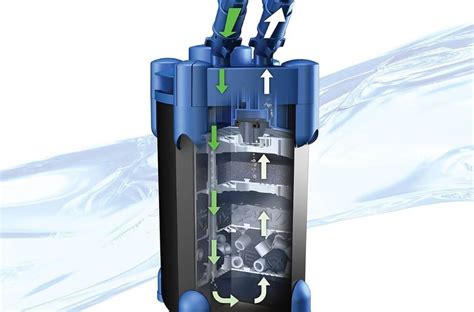How Does Canister Filter Work
Ronan Farrow
Mar 20, 2025 · 3 min read

Table of Contents
How Does a Canister Filter Work? A Comprehensive Guide
Choosing the right filter for your aquarium is crucial for maintaining a healthy environment for your fish. Canister filters are a popular choice among aquarists due to their efficiency and effectiveness. But how do they actually work? This comprehensive guide will break down the process, covering the components, the filtration stages, and the benefits of using a canister filter.
Understanding the Components of a Canister Filter
A canister filter is comprised of several key components working in harmony to keep your aquarium water clean and clear. These components typically include:
1. The Canister:
This is the main body of the filter, housing the filter media and the pump. It's usually made of durable plastic and sits outside the aquarium, connected via intake and output tubes. The canister's size directly impacts its filtration capacity. Larger canisters can handle larger aquariums and higher bioloads.
2. The Impeller Pump:
This is the heart of the system. The impeller pump draws water from the aquarium through the intake tube, forcing it through the filter media. The power of the pump determines the filter's flow rate. Higher flow rates are beneficial for larger tanks and maintaining better water circulation.
3. The Intake and Output Tubes:
These tubes connect the canister to the aquarium, allowing for water intake and return. Proper placement of these tubes is crucial for effective water circulation and to avoid dead zones within the aquarium.
4. The Filter Media:
This is where the magic happens! Different types of filter media work together to remove various impurities from the water. This usually includes:
- Mechanical Media: This is often the first stage of filtration, trapping larger debris like fish waste and uneaten food. Examples include sponges and filter floss.
- Biological Media: This is where beneficial bacteria colonies thrive. These bacteria break down harmful ammonia and nitrite produced by fish waste into less toxic nitrate, a process known as the nitrogen cycle. Examples include ceramic rings, bio balls, and filter pads.
- Chemical Media: This media removes dissolved impurities and unwanted substances from the water, often using activated carbon. This helps to improve water clarity and remove discoloration.
The Filtration Process: Step-by-Step
The filtration process is a multi-stage process:
- Water Intake: Water is drawn from the aquarium through the intake tube and into the canister.
- Mechanical Filtration: The water first passes through the mechanical media, removing large particles.
- Biological Filtration: Next, the water flows through the biological media, where beneficial bacteria colonies break down harmful waste products.
- Chemical Filtration (Optional): If chemical media is used, the water then passes through this stage, removing dissolved impurities and improving water clarity.
- Water Return: Finally, the now-cleaned water is pumped back into the aquarium through the output tube.
Benefits of Using a Canister Filter
Canister filters offer several advantages over other types of aquarium filters:
- High Filtration Capacity: They offer superior filtration compared to internal or hang-on-back filters, making them ideal for larger aquariums.
- Quiet Operation: Canister filters are generally quieter than other filter types.
- Easy Maintenance: While they require cleaning, the filter media can usually be removed and cleaned without disturbing the entire filter setup.
- Versatile Filter Media Options: The ability to customize the filter media allows for tailored filtration based on your specific aquarium needs.
Choosing the Right Canister Filter for Your Aquarium
When choosing a canister filter, consider these factors:
- Tank Size: Select a filter with a flow rate appropriate for your aquarium's size.
- Bioload: Consider the number and type of fish in your aquarium, as this will influence the filter's capacity.
- Maintenance Requirements: Choose a filter that is easy to clean and maintain.
By understanding how a canister filter works, you can make an informed decision on whether it's the right choice for your aquarium and ensure a healthy and thriving environment for your aquatic pets. Remember to always follow the manufacturer's instructions for setup, maintenance, and cleaning.
Featured Posts
Also read the following articles
| Article Title | Date |
|---|---|
| How To Write The Brown Supplemental Essays | Mar 20, 2025 |
| How Can I Believe In God Again | Mar 20, 2025 |
| How Big Is 8x12 Picture | Mar 20, 2025 |
| How Do You Putt On A Golf Simulator | Mar 20, 2025 |
| How To Train Your Dragon 2 Subtitles | Mar 20, 2025 |
Latest Posts
Thank you for visiting our website which covers about How Does Canister Filter Work . We hope the information provided has been useful to you. Feel free to contact us if you have any questions or need further assistance. See you next time and don't miss to bookmark.
